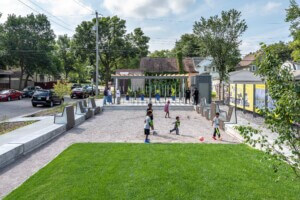A big, red fluttering heart will be aglow in Times Square this coming Valentine’s Day. Brooklyn-based, Venezuelan-born firm, Stereotank, has been named the winner of the 2015 Times Square Valentine Heart Design for its HEARTBEAT sculpture. The firm was invited, among others, to conceive a proposal for a Valentine’s Day–inspired installation, located among the many glimmering lights of the Great White Way. The Times Square Alliance, in partnership with the Architectural League of New York, selected the winning proposal, which will open on February 9th.
Stereotank’s HEARTBEAT is an interactive installation in the shape of a large heart, designed to glow along with the rhythm of a resonating heartbeat sound, set to a low frequency. Percussion instruments flank both sides of sculpture. The pace of the sound of this life-size beating heart will change in response to the movement and engagement of visitors as they near the sculpture and tap on its drums—each of which produces distinct sounds from different sized membranes and materials, including synthetic snare skin, synthetic snare skin will coil, animal hide, and hard plastic.
“What’s common between Love and Music? Love is about sharing and being ‘in tune’ with somebody, so it is the creation of music, a concert is a combined action where the performers are also ‘in tune’ creating harmony. Heartbeat orchestrates Times Square’s unique, active, flickering atmosphere,” said Stereotank architects Sara Valente and Marcelo Ertorteguy in a statement.
This year’s finalists included Alibi Studio; The Bittertang Farm & James Lowder; Chat Travieso; Modu Architecture; SLO Architecture; and Taylor Miller. Past winners of the competition, now in its seventh year, have included Young Projects (2014); Situ Studio (2013); BIG (Bjarke Ingels Group) (2012); Freecell (2011); Moorhead & Moorhead (2010); and Gage / Clemenceau Architects (2009).
“The combination of an interactive heart beat that increases with approach and the music making capacities is very interesting,” stated Barry Bergdoll, part of the Selection Committee and the Meyer Shapiro Professor of Art History and Archaeology, Columbia University. “It is an impressive object to occupy this space of cacophony, with sufficient red mass to be enjoyed even by wheeled passersby.”










